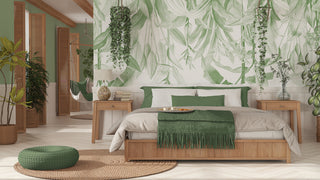Creating a sustainable lifestyle is not just about reducing your carbon footprint and using eco-friendly products, although these are are certainly beneficial. It may interest you to know that the broader concept of "sustainability" also benefits people as well as the environment.
The United Nations' 17 Sustainable Development Goals, set forth in 2012, are a helpful guide that each of us can look at to expand our own sustainable goals. In the meantime, the easiest way to start a journey towards responsible living is where we spend most of our time: in the home.
When you opt for sustainable home decor and furniture materials, you are contributing to a better environment while also supporting ethical businesses.
Below, we've provided a few tips on how to identify sustainable materials and to design your interiors with responsibly made furniture including organic fabrics that are free from toxic chemicals. Plus, we'll examine why choosing fair trade products over fast-and-cheap materials can lead to a reciprocally beneficial life.
1. Practice how to identify sustainable materials
Sustainability is all about using resources in a way that doesn't deplete them. When selecting home decor and furniture materials, look into the type of fabric, wood, and metals used. Ask questions when buying major appliances, beds and larger furniture items, like a couch or dining table, to understand if they're made with renewable resources and can be recycled easily. Or shop reused and repurposed products.
Materials such as bamboo, cork, and reclaimed wood are environmentally friendly and can be made into beautiful furniture and decor.
Sustainable rugs and carpets made from wool and jute are also great options as they are free from chemicals and synthetic dyes.
Not in the market for major purchases? Start small and slowly increase your sustainable footprint. The next time you need to replace dish soap, consider a zero-waste dish block with a bamboo soap holder and brush. It gets easier after that first conscious purchase!

2. Fair trade helps everyone from the supply chain to your home
Fair trade products ensure that the artisans and farmers who produce them receive a fair wage for their work. When you choose fair trade home decor and furniture materials, especially on fair trade certified products, you can be sure that you are supporting ethical practices.
Products such as bed and bath linens, kitchen and dining utensils, and home decor accents are often handmade and have a unique quality that adds a personal and inviting touch to your home. While the handmade products sold at discount stores can have a similar look, ask yourself how the retailer is able to discount so deeply. The answer you end with just may be that someone is not getting their fair share of your purchase.
Look for products that have received certifications from organizations such as Fair Trade USA, Rainforest Alliance, and Forest Stewardship Council (FSC).
3. Let energy-efficient lighting guide your way to sustainability
Lighting can also play a crucial role in creating a sustainable home. Choose LED lights that are energy-efficient and have a long lifespan. Decorate your home with natural light by maximizing the use of windows and skylights to reduce your energy consumption.

4. Minimizing waste leads to a cleaner household
Another way to create a sustainable home is by minimizing waste. Choose home decor pieces that are multipurpose and functional. This can include furniture with built-in storage or pieces made from recycled materials.
Choose reusable items such as washable facial pads that replace single-use cotton and biodegradable cleaning products, and avoid single-use plastic items as much as possible.
We're absolutely not saying to throw out all of your current plastic items, staying mindful of overflowing landfills and all of the plastic waste found in the ocean. With that said, once you notice a plastic product has seen its last days, simply replace it with something that's not made of plastic and instead made from a sustainable material. Done and done.
5. Bring nature indoors with plants as decor
Adding indoor plants to your decor will not only make your home look more nature-forward, but also serve as an eco-friendly way to purify the air.
That's right! Through the process of photosynthesis, plants use sunlight to convert carbon dioxide into oxygen and sugars. Plants also absorb and filter toxins, such as carbon monoxide, nitrogen dioxide, and sulfur dioxide from the air. These are all harmful pollutants that can cause respiratory problems and worsen the impacts of our atmosphere.
Once you've added plants into your living environment, be sure to consider the supplements you're feeding them, so they, too, can live a long and healthy life.
Shop: We the Wild's Organic Plant "Let It Grow" Kit
Our homes are a reflection of the individual choices we make each day. Creating a sustainable home is a conscious effort that requires thoughtful choices in the materials and products we choose.
By selecting home decor and materials that make our lives and the lives of others better, we are taking a step towards a more cohesive environment while also supporting ethical practices. Identifying sustainable materials, choosing fair trade products, minimizing waste, opting for energy-efficient furniture and accessories, and adding plants for a greener interior (pun intended) are all ways to create a sustainable and inviting home that reflects the message: you care.
Let's all take steps toward building a better future for ourselves and the planet, together.

